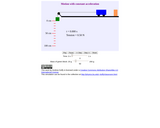
This simulation is about Motion with Constant Acceleration
هذه المحاكاة تشرح عن الحركة مع التسارع المستمر
- Subject:
- Physical Science
- Physics
- Material Type:
- Simulation
- Provider:
- Boston University
- Author:
- Andrew Duffy
- Date Added:
- 12/22/2016

This simulation is about Motion with Constant Acceleration
هذه المحاكاة تشرح عن الحركة مع التسارع المستمر
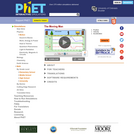
Learn about position, velocity, and acceleration graphs. Move the little man back and forth with the mouse and plot his motion. Set the position, velocity, or acceleration and let the simulation move the man for you.
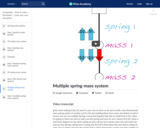
Now we'll add another spring and mass to our system.

Searchable database of resources and opportunities for students and educators. See Citizen Science opportunities for assignment and activity inspiration. See All Topics index in addition to the Educational Materials search.

Land Rush plunges the gamer in a simulation of a rush for land and natural resources. Players take up the role of poor, middle-class or rich farmers. They compete for scarce natural resources. They make choices about crop and production techniques. And they face unforeseeable events with a positive or negative impact upon their livelihoods. ***** .
Land Rush plonge les joueurs dans une simulation de compétition pour la terre. Les joueurs assument le rôle d'un paysan pauvre, de la classe moyenne ou riche. Ils rentrent en compétition pour les ressources foncières disponibles. Ils prennent des décisions par rapport aux cultures et techniques de production à adopter. Et ils font face à certains évènements avec un impact positif ou négatif sur leurs moyens d'existence. ***** .
Land Rush sumerge al jugador en una simulación de una carrera por la tierra y los recursos naturales. Los jugadores toman el papel de agricultores pobres, de clase media o agricultores ricos. Ellos compiten por los escasos recursos naturales. Ellos deciden sobre las técnicas de siembra y producción a seguir. Además enfrentan eventos imprevisibles que tendrán un impacto positivo o negativo sobre sus medios de vida.

The Shiny@UCLouvain platform is a repository for sharing teaching resources created in Shiny for the Catholic University of Louvain (UCLouvain) with the aim of teaching statistics with interactive apps. The list of apps (Inference, Probability, Distributions, Central Limit Theorem, Confidence intervals, Hypothesis test on the mean, Bootstrap confidence intervals, Design of Experiments , ...) associated with the RShiny@UCLouvain platform can be found at https://sites.uclouvain.be/RShiny/main.html . The source code of the apps can be found at https://forge.uclouvain.be/rshiny_uclouvain .

Open data, research, code, images, video, and resources. Also includes information on funding and policy. See Solve, Citizen Science, and COECI.
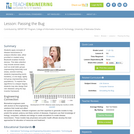
Students apply concepts of disease transmission to analyze infection data, either provided or created using Bluetooth-enabled Android devices. This data collection may include several cases, such as small static groups (representing historically rural areas), several roaming students (representing world-travelers), or one large, tightly knit group (representing urban populations). To explore the algorithms to a deeper degree, students may also design their own diseases using the App Inventor framework.
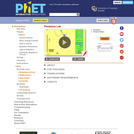
Play with one or two pendulums and discover how the period of a simple pendulum depends on the length of the string, the mass of the pendulum bob, and the amplitude of the swing. It's easy to measure the period using the photogate timer. You can vary friction and the strength of gravity. Use the pendulum to find the value of g on planet X. Notice the anharmonic behavior at large amplitude.

This is a quiz designed to accompany the online simulation "Under Pressure," which is part of the PhET Interactive Simulations of the University of Colorado Boulder.The quiz was designed for Canvas. Each question includes instructions for an action the student is to complete in the online simulation, followed by a multiple choice question.

This is a quiz designed to accompany the online simulation "Forces and Motion," which is part of the PhET Interactive Simulations of the University of Colorado Boulder.The quiz was designed for Canvas. Each question includes instructions for an action the student is to complete in the online simulation, followed by a multiple choice question.

This is a quiz designed to accompany the online simulation "Collision Lab," which is part of the PhET Interactive Simulations of the University of Colorado Boulder. The quiz was designed for Canvas. Each question includes instructions for an action the student is to complete in the online simulation, followed by a multiple choice question.

This is a quiz designed to accompany the online simulation "Energy Skate Park: Basics," which is part of the PhET Interactive Simulations of the University of Colorado Boulder.The quiz was designed for Canvas. Each question includes instructions for an action the student is to complete in the online simulation, followed by a multiple choice question.
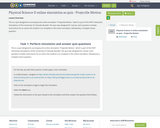
This is a quiz designed to accompany the online simulation "Projectile Motion," which is part of the PhET Interactive Simulations of the University of Colorado Boulder.The quiz was designed for Canvas. Each question includes instructions for an action the student is to complete in the online simulation, followed by a multiple choice question.
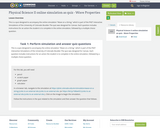
This is a quiz designed to accompany the online simulation "Wave on a String," which is part of the PhET Interactive Simulations of the University of Colorado Boulder.The quiz was designed for Canvas. Each question includes instructions for an action the student is to complete in the online simulation, followed by a multiple choice question.
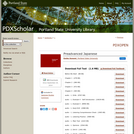
This textbook is designed for students who have intermediate competency in Japanese, roughly at Level 2 on the ILR (The Interagency Language Roundtable) proficiency scale, and are working on reaching Level 3.
This textbook can be used for self-study, as part of online course, and in a traditional classroom setting. It is comprised of four chapters, intended to be covered in one term of a quarter system.

Google Slide presentation containing videos on multiple probability rules and application topics.
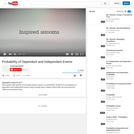
Sixth grade math teacher Ana Posada shares a lesson on probability. Students do simulations of dependent and independent events using a goody bag of objects where they can document the differences between them.
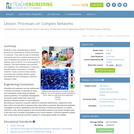
Building on their understanding of graphs, students are introduced to random processes on networks. They walk through an illustrative example to see how a random process can be used to represent the spread of an infectious disease, such as the flu, on a social network of students. This demonstrates how scientists and engineers use mathematics to model and simulate random processes on complex networks. Topics covered include random processes and modeling disease spread, specifically the SIR (susceptible, infectious, resistant) model.

This is a first course in project management, one in which students will learn the knowledge, skills, and abilities necessary to be an effective project manager. They will learn how to plan, execute, and monitor a project. The course will cover the latest theories and concepts on scoping, stakeholder management, team leadership, budgeting and contracting, scheduling, quality control and assurance, and risk management. Students will have the option to apply their learning to a real-world project.